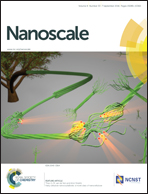Photosensitizer cross-linked nano-micelle platform for multimodal imaging guided synergistic photothermal/photodynamic therapy†
Abstract
The multifunctional nano-micelle platform holds great promise to enhance the accuracy and efficiency of cancer diagnosis and therapy. In this work, an amphiphilic poly[(poly(ethylene glycol) methyl ether methacrylate)-co-(3-aminopropyl methacrylate)]-block-poly(methyl methacrylate) (P(PEGMA-co-APMA)-b-PMMA) block copolymer was synthesized by successive RAFT polymerizations and subsequent chemical modification. Then the multifunctional micelles with high solubility in physiological environments were developed by a self-assembly and crosslinking processes. The photosensitizer segment, 5,10,15,20-tetrakis (4-carboxyphenyl) porphyrin (TCPP), serves as a tetra-functional cross-linker, photodynamic agent, fluorescence indicator, as well as magnetic resonance (MR) contrast agent after labelling with manganese ions (Mn2+), while IR825 simultaneously locating in the interior of the fabricated micelles contributed to the photoacoustic (PA) imaging ability and the photothermal effect. The prepared nanoparticles show great stability in a physiological environment with uniform morphology and diameters of around 80 nm as disclosed by stability investigation, TEM and DLS analysis. IR825@P(PEGMA-co-APMA)-b-PMMA@TCPP/Mn nanoparticles displayed high in vivo tumor uptake with a long blood circulation half-life (∼3.64 h) by the EPR effect after intravenous (i.v.) injection, as revealed by fluorescence, MR and PA imaging models. In vivo anti-tumor effects were achieved via a combined photothermal and photodynamic therapy without noticeable dark toxicity, and this strategy was able to induce a remarkably improved synergistic therapeutic effect to both superficial and deep regions of tumors under mild conditions compared with either single photothermal or photodynamic mechanisms.


 Please wait while we load your content...
Please wait while we load your content...